Charles E W Bean, Diaries, AWM38 3DRL 606/257/1 - 1916 - 1927 - Part 11
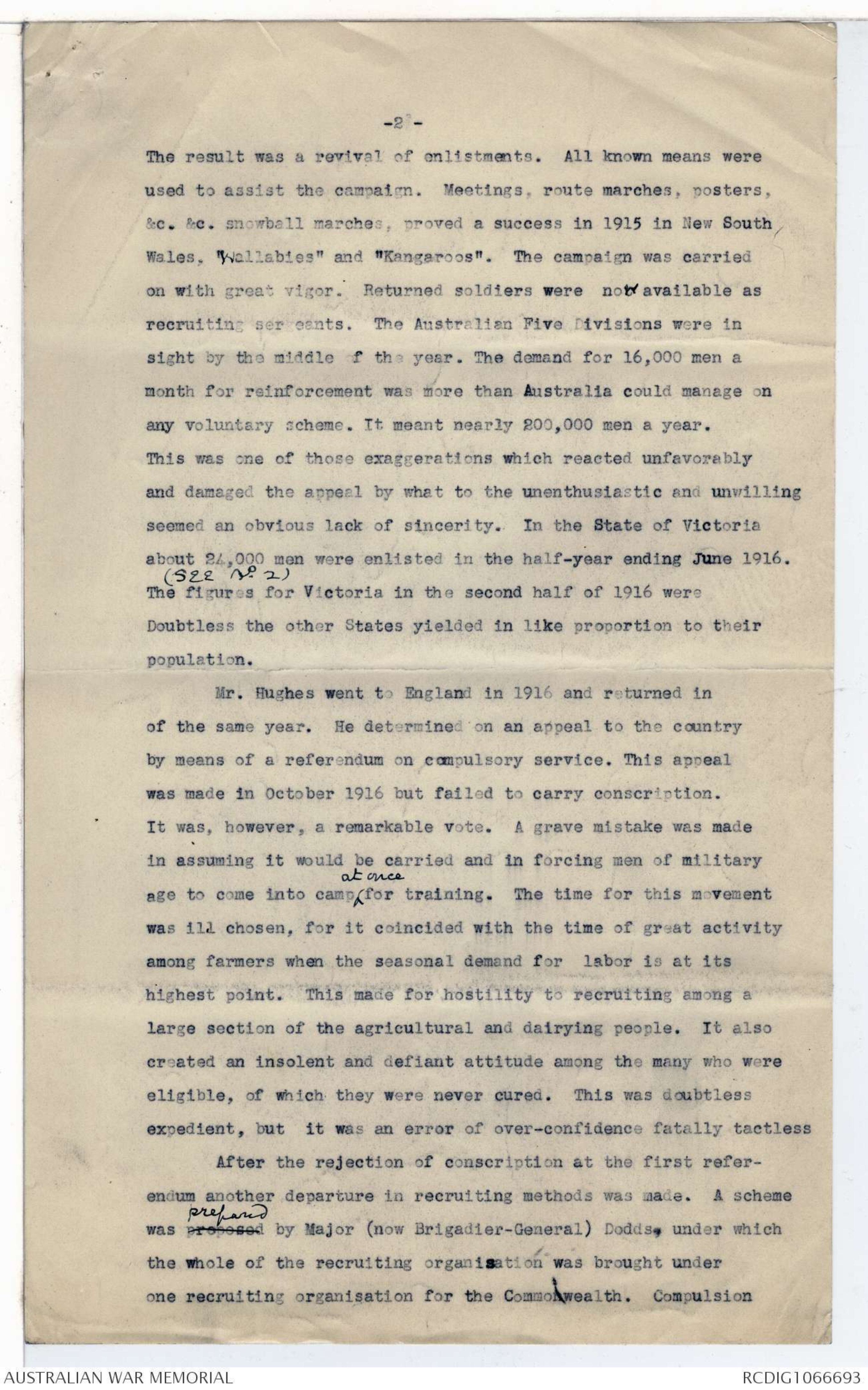

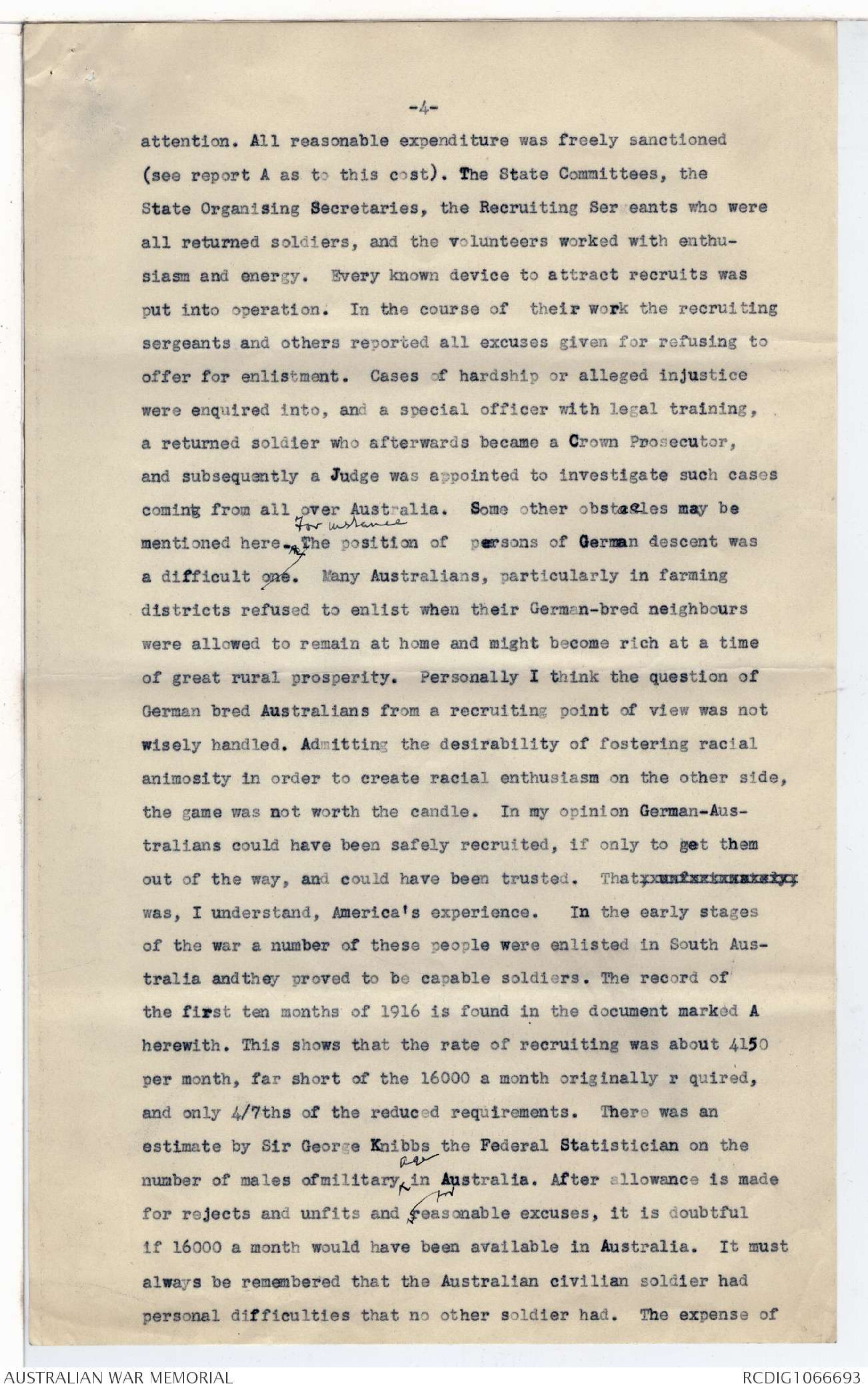
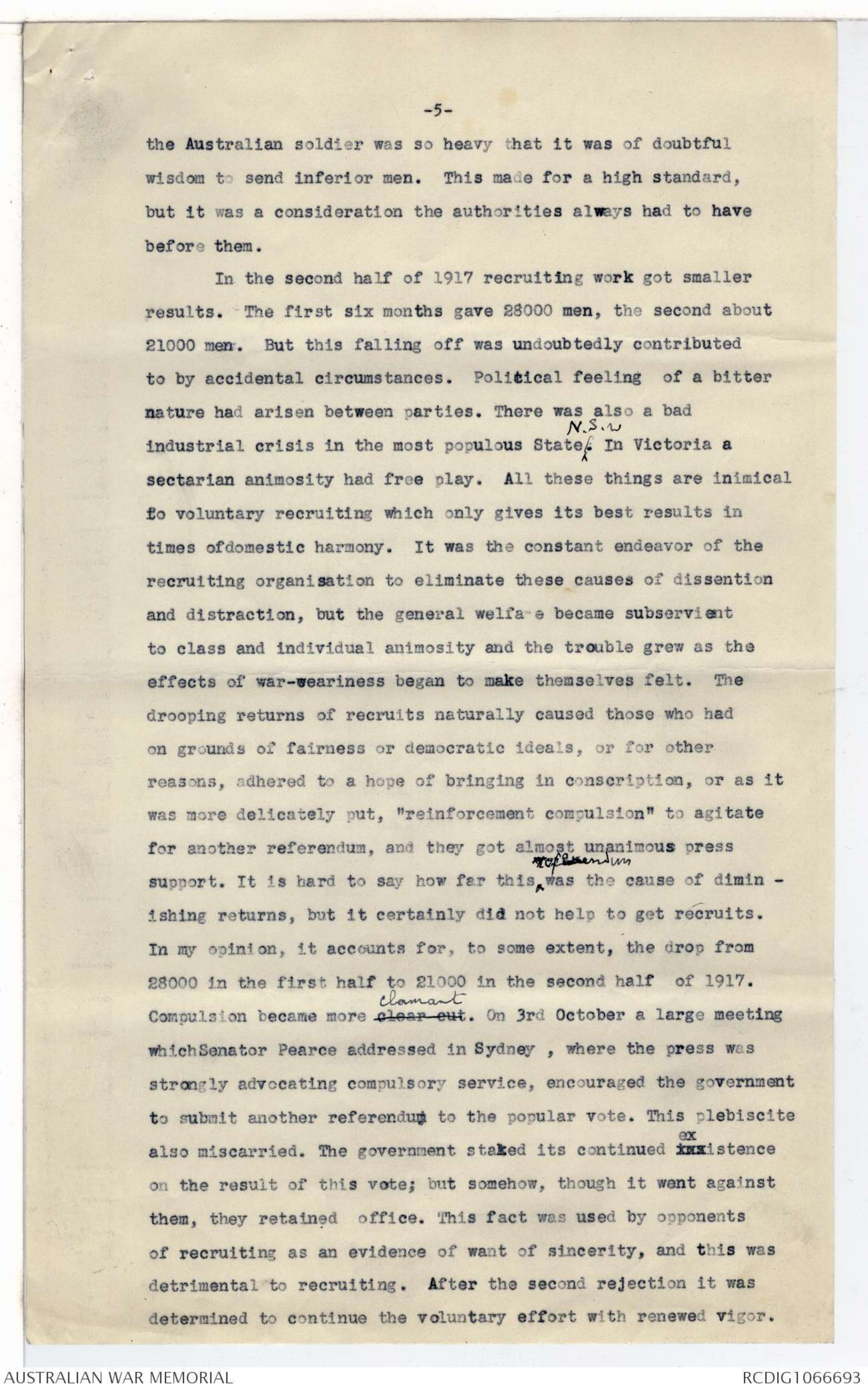
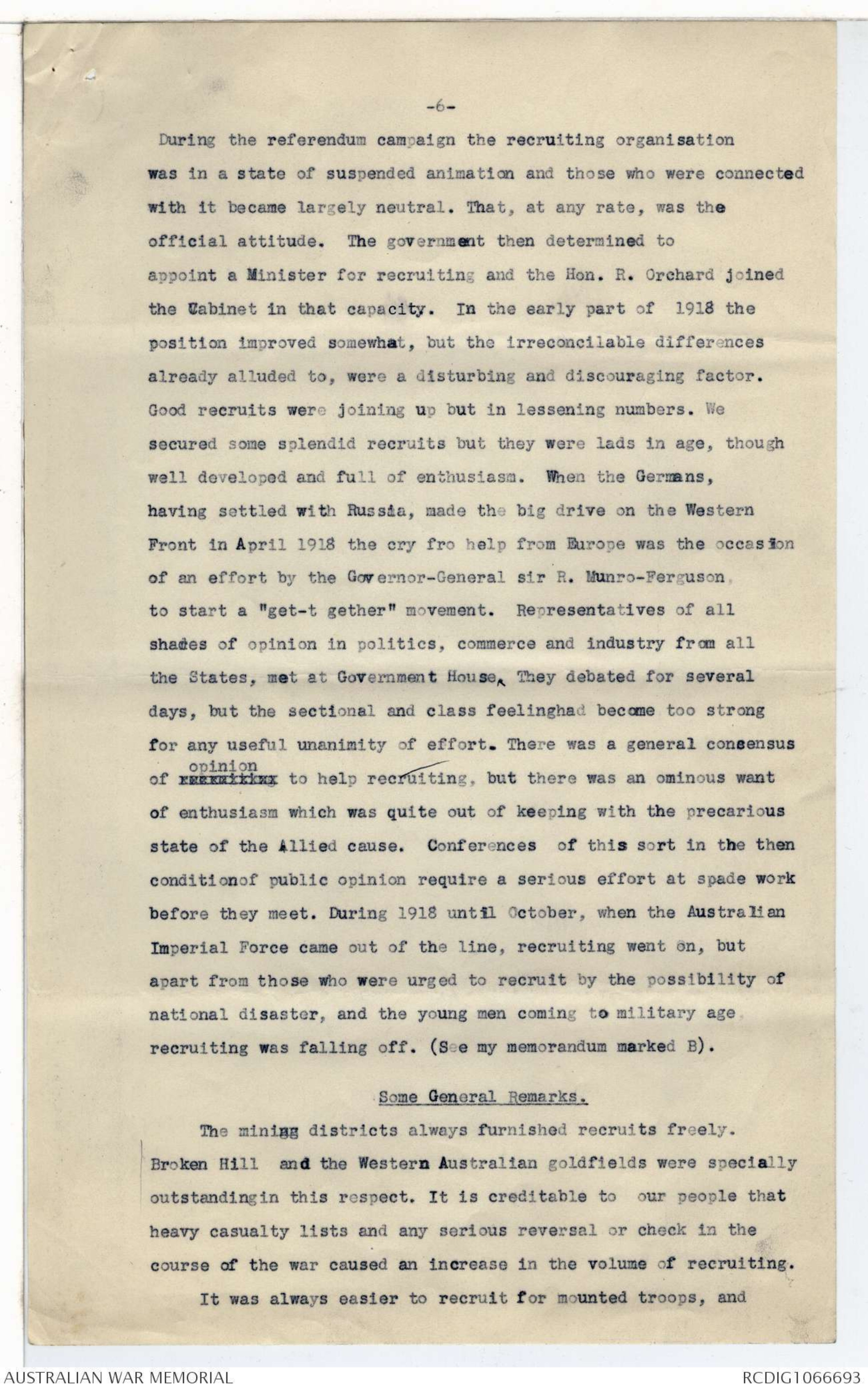
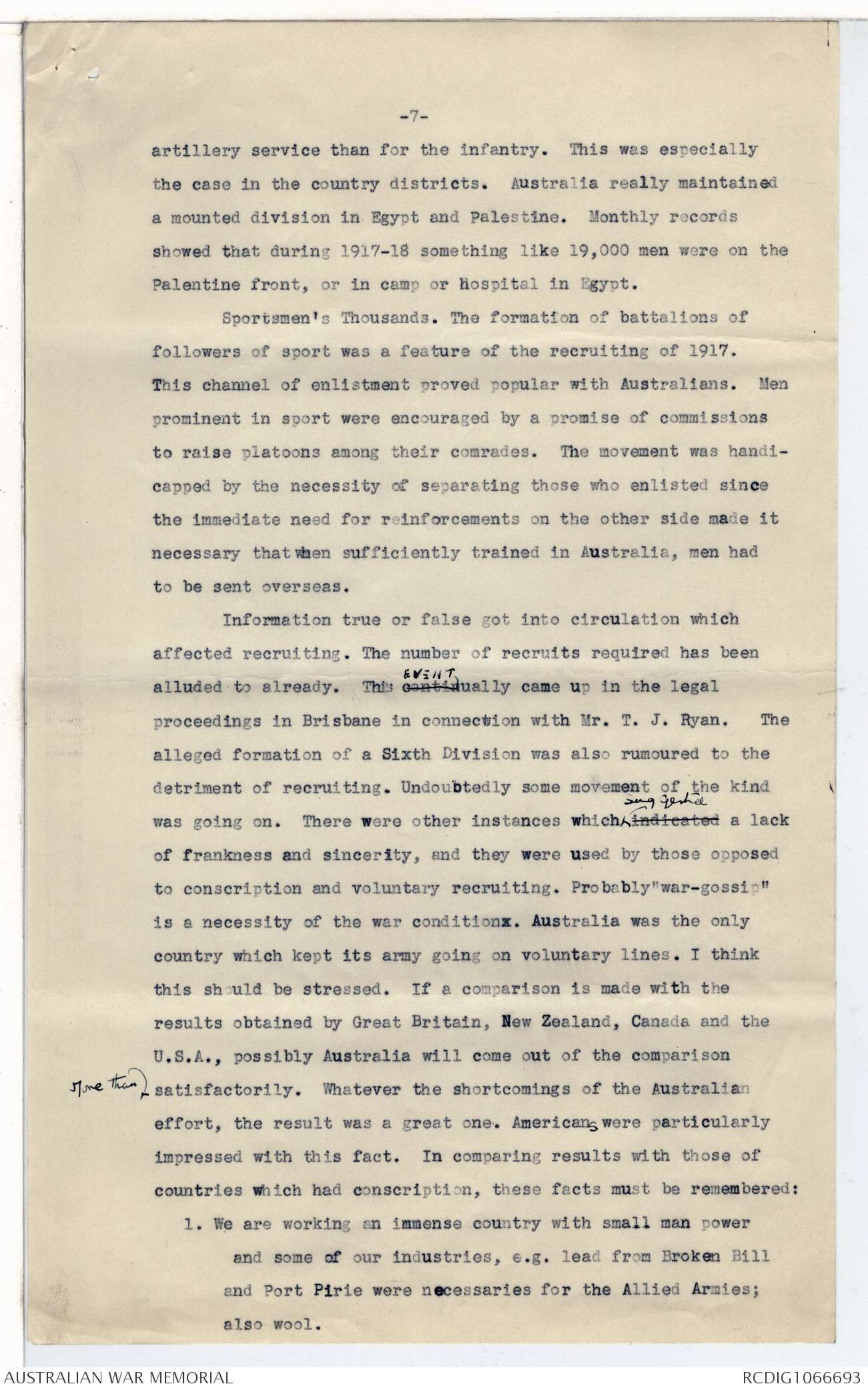



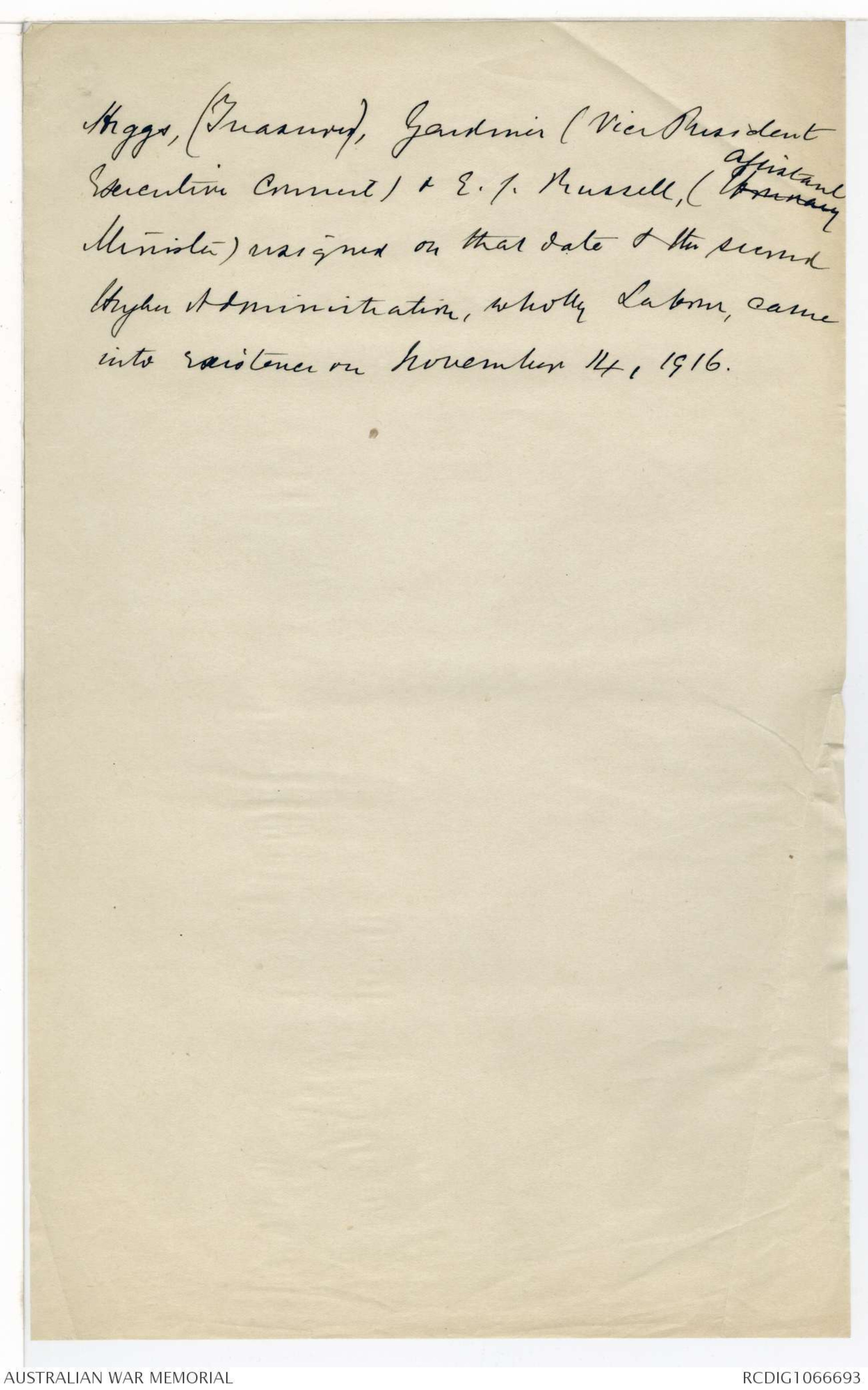
2
The result was a revival of enlistments. All known means were
used to assist the campaign. Meetings, route marches, posters,
&c. &c. snowball marches, proved a success in 1915 in New South,
Wales, "Wallabies" and "Kangaroos". The campaign was carried
on with great vigor. Returned soldiers were now available as
recruiting sergeants. The Australian Five Divisions were in
sight by the middle of the year. The demand for 16,000 men a
month for reinforcement was more than Australia could manage on
any voluntary scheme. It meant nearly 200,000 men a year.
This was one of those exaggerations which reacted unfavorably
and damaged the appeal by what to the unenthusiastic and unwilling
seemed an obvious lack of sincerity. In the State of Victoria
about 24,000 men were enlisted in the half-year ending June 1916.
[*(See No. 2)*]
The figures for Victoria in the second half of 1916 were
Doubtless the other States yielded in like proportion to their
population.
Mr. Hughes went to England in 1916 and returned in
of the same year. He determined on an appeal to the country
by means of a referendum on compulsory service. This appeal
was made in October 1916 but failed to carry conscription.
It was, however, a remarkable vote. A grave mistake was made
in assuming it would be carried and in forcing men of military
age to come into camp ^at once (for training. The time for this movement
was ill chosen, for it coincided with the time of great activity
among farmers when the seasonal demand for labor is at its
highest point. This made for hostility to recruiting among a
large section of the agricultural and dairying people. It also
created an insolent and defiant attitude among the many who were
eligible, of which they were never cured. This was doubtless
expedient, but it was an error of over-confidence fatally tactless
After the rejection of conscription at the first referendum
another departure in recruiting methods was made. A scheme
was proposed preferred by Major (now Brigadier-General) Dodds, under which
the whole of the recruiting organisation was brought under
one recruiting organisation for the Commonwealth. Compulsion
3
was impossible and many of those who had been active in the
recruiting campaign of 1916 were disposed to abandon further
effort in a voluntary way because they were compromised by
partisanship in the conscription campaign, or because they
logically enough considered that further effort was futile.
Most of the enthusiastic workers however persisted xxxxxx
The new scheme is set out in the printed paper herewith ^(No. 1). The
existing organisations (local) were as far as possible brought
into the work. The State recruiting committees were drawn from
all political parties ^See list of names in "A" herewith The task in hand was to maintain in full
fighting strength the five Divisions which constituted the
Australian Imperial force. There was some confusion as toeconomical numerical requirements. Certain figures were obtained from
the British War Office indicating those requirements. They made
a big demand on Available Australian manpower and obviously
there could hardly be unanimity as to what the actual requirements
were. Some of those engaged in the recruiting work were discouraged
by the large figures of the demand. The numbers of the
Australian Army were in a singular position; they were 12,000
miles from their homes and satisfactory furlough was impossible.
They ^also became storm troops and ^were therefore exposed to heavy
casualties. As a matter ofhistory their casualties were no
heavier than those of other sections of the Empire's forces,
but they were undoubtedly exposed to this risk. For these and
other reasons it was impossible to estimate the actual requirement
As a matter of fact the estimates from Europe varied considerably
and the knowledge of these varying estimates got about. The
instructions were to get 16,000 men a month. This number was soon
after as the result of xxxxxxx experience xxxx reduced to
7000 a month. The work was taken up enthusiastically. The
government made many concessions in the way of pay and other
allowances. The recruiting committees in each State made useful
suggestions, and many of these were taken up by the Government.
The Minister of Defence (Senator Pearce) and the Army Staff,
gave all demands, recommendations &c. serious appreciative
4
attention. All reasonable expenditure was freely sanctioned
(see report A as to this cost). The State Committees, the
State Organising Secretaries, the Recruiting Sergeants who were
all returned soldiers, and the volunteers worked with enthusiasm
and energy. Every known device to attract recruits was
put into operation. In the course of their work the recruiting
sergeants and others reported all excuses given for refusing to
offer for enlistment. Cases of hardship or alleged injustice
were enquired into, and a special officer with legal training,
a returned soldier who afterwards became a Crown Prosecutor,
and subsequently a Judge was appointed to investigate such cases
coming from all over Australia. Some other obstacles may be
mentioned here. ^For instance The position of persons of German descent was
a difficult one. Many Australians, particularly in farming
districts refused to enlist when their German-bred neighbours
were allowed to remain at home and might become rich at a time
of great rural prosperity. Personally I think the question of
German bred Australians from a recruiting point of view was not
wisely handled. Admitting the desirability of fostering racial
animosity in order to create racial enthusiasm on the other side,
the game was not worth the candle. In my opinion German-
Australians could have been safely recruited, if only to get them
out of the way, and could have been trusted. That xxxxxxxxxxxx
was, I understand, America's experience. In the early stages
of the war a number of these people were enlisted in South Australia
andthey proved to be capable soldiers. The record of
the first ten months of 1916 is found in the document marked A
herewith. This shows that the rate of recruiting was about 4150
per month, far short of the 16000 a month originally required,
and only 4/7ths of the reduced requirements. There was an
estimate by Sir George Knibbs the Federal Statistician on the
number of males ofmilitary ^age in Australia. After allowance is made
for rejects and unfits and ^for reasonable excuses, it is doubtful
if 16000 a month would have been available in Australia. It must
always be remembered that the Australian civilian soldier had
personal difficulties that no other soldier had. The expense of
5
the Australian soldier was so heavy that it was of doubtful
wisdom to send inferior men. This made for a high standard,
but it was a consideration the authorities always had to have
before them.
In the second half of 1917 recruiting work got smaller
results. The first six months gave 28000 men, the second about
21000 men. But this falling off was undoubtedly contributed
to by accidental circumstances. Political feeling of a bitter
nature had arisen between parties. There was also a bad
industrial crisis in the most populous State ^N.S.W. In Victoria a
sectarian animosity had free play. All these things are inimical
to voluntary recruiting which only gives its best results in
times ofdomestic harmony. It was the constant endeavor of the
recruiting organisation to eliminate these causes of dissention
and distraction, but the general welfare became subservient
to class and individual animosity and the trouble grew as the
effects of war-weariness began to make themselves felt. The
drooping returns of recruits naturally caused those who had
on grounds of fairness or democratic ideals, or for other
reasons, adhered to a hope of bringing in conscription, or as it
was more delicately put, "reinforcement compulsion" to agitate
for another referendum, and they got almost unanimous press
support. It is hard to say how far this, ^referendum was the cause of
diminishing returns, but it certainly did not help to get recruits.
In my opinion, it accounts for, to some extent, the drop from
28000 in the first half to 21000 in the second half of 1917.
Compulsion became more clear cut clamant. On 3rd October a large meeting
whichSenator Pearce addressed in Sydney, where the press was
strongly advocating compulsory service, encouraged the government
to submit another referendum to the popular vote. This plebiscite
also miscarried. The government staked its continued xx existence
on the result of this vote; but somehow, though it went against
them, they retained office. This fact was used by opponents
of recruiting as an evidence of want of sincerity, and this was
detrimental to recruiting. After the second rejection it was
determined to continue the voluntary effort with renewed vigor.
6
During the referendum campaign the recruiting organisation
was in a state of suspended animation and those who were connected
with it became largely neutral. That, at any rate, was the
official attitude. The government then determined to
appoint a Minister for recruiting and the Hon. R. Orchard joined
the Cabinet in that capacity. In the early part of 1918 the
position improved somewhat, but the irreconcilable differences
already alluded to, were a disturbing and discouraging factor.
Good recruits were joining up but in lessening numbers. We
secured some splendid recruits but they were lads in age, though
well developed and full of enthusiasm. When the Germans,
having settled with Russia, made the big drive on the Western
Front in April 1918 the cry fro help from Europe was the occasion
of an effort by the Governor-General sir R. Munro-Ferguson
to start a "get-t gether" movement. Representatives of all
shades of opinion in politics, commerce and industry from all
the States, met at Government House. They debated for several
days, but the sectional and class feelinghad become too strong
for any useful unanimity of effort. There was a general consensus
of xxxxxxx opinion to help recruiting, but there was an ominous want
of enthusiasm which was quite out of keeping with the precarious
state of the Allied cause. Conferences of this sort in the then
conditionof public opinion require a serious effort at spade work
before they meet. During 1918 until October, when the Australian
Imperial Force came out of the line, recruiting went on, but
apart from those who were urged to recruit by the possibility of
national disaster, and the young men coming to military age
recruiting was falling off. (See my memorandum marked B).
Some General Remarks.
The mining districts always furnished recruits freely.
Broken Hill and the Western Australian goldfields were specially
outstandingin this respect. It is creditable to our people that
heavy casualty lists and any serious reversal or check in the
course of the war caused an increase in the volume of recruiting.
It was always easier to recruit for mounted troops, and
7
artillery service than for the infantry. This was especially
the case in the country districts. Australia really maintained
a mounted division in Egypt and Palestine. Monthly records
showed that during 1917-18 something like 19,000 men were on the
Palentine front, or in camp or Hospital in Egypt.
Sportsmen's Thousands. The formation of battalions of
followers of sport was a feature of the recruiting of 1917.
This channel of enlistment proved popular with Australians. Men
prominent in sport were encouraged by a promise of commissions
to raise platoons among their comrades. The movement was
handicapped by the necessity of separating those who enlisted since
the immediate need for reinforcements on the other side made it
necessary that when sufficiently trained in Australia, men had
to be sent overseas.
Information true or false got into circulation which
affected recruiting. The number of recruits required has been
alluded to already. This contin eventually came up in the legal
proceedings in Brisbane in connection with Mr. T. J. Ryan. The
alleged formation of a Sixth Division was also rumoured to the
detriment of recruiting. Undoubtedly some movement of the kind
was going on. There were other instances which indicated ^suggested a lack
of frankness and sincerity, and they were used by those opposed
to conscription and voluntary recruiting. Probably"war-gossip"
is a necessity of the war conditionx. Australia was the only
country which kept its army going on voluntary lines. I think
this should be stressed. If a comparison is made with the
results obtained by Great Britain, New Zealand, Canada and the
U.S.A., possibly Australia will come out of the comparison
^more than satisfactorily. Whatever the shortcomings of the Australian
effort, the result was a great one. Americans were particularly
impressed with this fact. In comparing results with those of
countries which had conscription, these facts must be remembered:
1. We are working an immense country with small man power
and some of our industries, e.g. lead from Broken Hill
and Port Pirie were necessaries for the Allied Armies;
also wool.
8
2. Except the railway units none of our men were labor
battalions.
3. We could not send inferior or doubtful men on our
Australian conditions of pay, etc.
4. Five Australian Divisions and another Mounted Division
were in the field when the war was ^practically concluded.
Special appeals for personal contingents were made
during 1917-18. The most notable of these were those of
Captain Carmichael in New South Wales, the Premier Mr. Ryan in
Queensland and Colonel Butler, in South Australia. All of
these efforts got good results. Captain Carmichael and Colonel
Butler were returned soldiers, and in Mr. Ryan's case the
records show that many of the recruits desired to be identified
with his contingent personally. Unfortunately party feeling in
Queensland ran rather unduly high and marred an otherwise successful
effort. Personal appeals by outstanding returned soldiers who
are returning to the front, or by responsible public men give a
personal touch which brings results.
During 1916 it was necessary for Mr Hughes to pay a visit
to England and there he found the war & the general
situation were giving concern. When he reached
Australia toward the end of the in August of that year he began to consult
his own party as to what could be done to open up
reinforcements and keep our force in the field up at xx full strength. But the Labour conferences of earlier
in the year had pronounced adversely to conscription.
It was the opinion of many within the party
that this was a mistaken policy and that had he been
in Australia Mr Hughes might persuaded Labour not
to have so decided. But the events in Dublin
earlier in the same year was now of dominant considerable
influence in the Australian political labour party.
Hughes, notwithstanding his knowledge of the war
situation on the in Europe, could not ask his party in
or outside of Parliament to reverse their decision
against conscription, nor could he as a democrat
attempt to force the people to go abroad to war
whether they would or no. The matter the next
steps was debated for three nights in a full party
meeting in Melbourne. At length Mr Catts had moved a
motion which if carried would have involved the defeat
of Mr Hughes as leader of the party. Mr Charlton
had moved as an amendment that the executive
was not satisfactory to Hughes as it brought him &
his Ministerial policy under the same xxx of reviewas the Catts' motion. At length Hughes
said practically that the time was come for action.
It was idle to spend more time on talk. I shall
now leave the chair & call upon ^all those who believe
in Australia and who put the Empire first to
follow me. Hughes then left the room & 24 members
of the party in the Senate & the House of
Representatives followed him, among whom the
principal were [Myer?] Poynton, Archibald, Spence,
Bamford, Burchell, Jensen, Webster, Laird
Smith, Thomas, Pearce, Russell, De Largie,
Henderson, Lynch, Guthrie, Buzacott & Givens.
The date of that meeting would be sometime
about the 27th October, 1916, for three Ministers
Higgs, (Treasury), Gardiner, (Vice President
Executive Council) & E. J. Russell, (Ordinary Assistant
MInister) resigned on that date & the second
Hughes Administration, wholly Labour, came
into existence on November 14, 1916.
 Sam scott
Sam scottThis transcription item is now locked to you for editing. To release the lock either Save your changes or Cancel.
This lock will be automatically released after 60 minutes of inactivity.